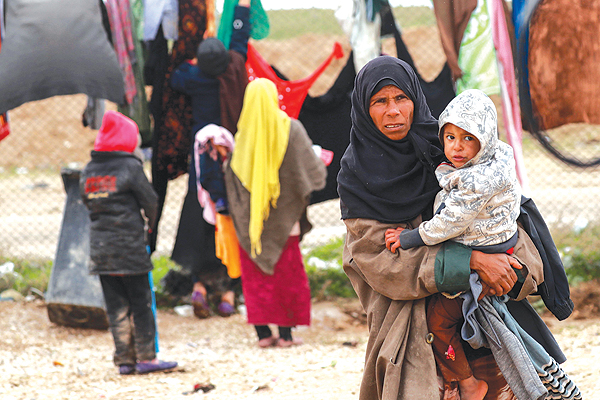Hundreds of bodies found in mass graves

AL-HOL, Syria: Faraj was born in the pouring rain on a nondescript stretch of desert road in eastern Syria as his family fled escalating fighting over the Islamic State group's last bastion. His family was part of a group of around 200 civilians who managed to escape from a pocket of territory in Deir Ezzor province that is still held by the jihadists. "I had to resist hunger, cold and rain," the newborn's mother Kamela Fadel said in a camp for displaced people in the northeastern region of Al-Hol.
The young woman, her husband and their four children now sleep under white tents, with hundreds of other people who fled eastern flashpoints in past weeks. They are huddled on straw mats laid out directly on the gravelly earth, wrapped in blankets and hugging bags packed with their meagre belongings.
A nurse helps an elderly lady to the camp clinic as children play at scaling piles of foam mattresses and families sit cross-legged, eating from tin cans. It is still cold in the vast tent but at least they are sheltered from the rain. They walked for several days in the winter weather before being met last week by the Kurdish-led Syrian Democratic Forces (SDF) battling IS in Deir Ezzor. "It was hunger that prompted us to leave, there was nothing left to eat," says Kamela's husband, still sporting the thick beard the jihadists impose on all adult men.
'Destruction everywhere'
He and his family were living in Al-Shaafa, one of the last villages, together with Sousa and Hajin, that are still under the control of IS. The SDF, with the support of air strikes by the US-led coalition against IS, launched a major operation against the last rump of the jihadists' moribund "caliphate" in September this year. The jihadists hunkering down in their Euphrates Valley heartland have offered stiff resistance, thwarting coalition hopes of a quick victory.
Warplanes have been raining bombs on IS targets in and around Hajin, causing significant civilian loss of life in the process, according to the Syrian Observatory for Human Rights. The Observatory says almost 320 civilians have been killed, including 113 children. "There is destruction everywhere because of the fighting and the bombardment. We were scared for the children," says Faraj's father. Local camp official Mohamed Ibrahim told AFP around 1,700 civilians had arrived in Al-Hol in recent days. The intensity of the bombardment and the remoteness of the area make it is difficult to estimate the number of civilians who remain, voluntarily or not, in the IS pocket.
"In Syria, displacement leads to food insecurity as people leave their belongings behind," said Marwa Awad, a spokeswoman for the UN's World Food Program in Damascus. "This is why it's vital to maintain a lifeline of food assistance for vulnerable families such as those escaping violence in Deir Ezzor," she said. Awad said at least 16,500 people had been forced to flee their homes in Hajin and surrounding areas since violence in the area intensified in July this year. SDF fighters too suffered heavy losses in their assault on Hajin, where a group of die-hard jihadists with little to lose are making a bloody last stand.
Last stand
"There are landmines everywhere on the roads," says Abu Omar, one of the displaced in Al-Hol. Fearing retribution against relatives who have stayed behind in IS-controlled territory, he refused to give his full name. "The village and our homes have been destroyed by the bombardment," says Abu Omar, a man in his thirties. "There are still high-ranking members of IS and foreigners there, but most are on the Hajin frontline," he says. "They won't give up easily, they are fighting to the death." The US-led coalition puts the number of jihadist fighters holding out in that area at around 2,000.
"The day we managed to flee, the fog was thick and gave us cover. Had they seen us, they would have wiped us out," says Ziba Al-Ahmed, who escaped the town of Sousa. "The bombardment was so scary and our bellies were crying," says the mother of four. Their farming machinery was too precious to leave in Sousa and her husband stayed behind with one of their daughters. "We're worried about them, we don't know what's going to happen to them."
Seven mass graves
Meanwhile, seven mass graves containing hundreds of unidentified bodies have been unearthed near the former Islamic State group stronghold of Albu Kamal in eastern Syria, official news agency SANA said. Most of the more than 100 bodies recovered so far at the site appear to "have been subjected to torture and ill-treatment before execution," it said, accusing IS of killing the victims. Work was under way to retrieve the rest of the bodies from the graves in the eastern province of Deir Ezzor, SANA said in its report published late Tuesday.
It released a video showing forensic experts in protective clothing recovering remains, and corpses laid out on the ground in a row under white sheets. A Syrian Red Crescent official said the main focus at present was identifying the remains already recovered which included those of several women. "Exhumations will resume afterwards," the official said, asking not to be identified. "The bodies show signs of torture and some were blindfolded and handcuffed."
IS has been held responsible for multiple atrocities during its reign of terror, including mass executions and decapitations. In recent months, both Syria and Iraq have discovered a number of mass graves in areas previously occupied by the jihadists. IS proclaimed a "caliphate" over swathes of the two countries in 2014, but has since lost almost all the territory it once held. Albu Kamal, which lies in the Euphrates Valley near the border with Iraq, was the last major town that IS controlled fully before losing it in November 2017.- Agencies




